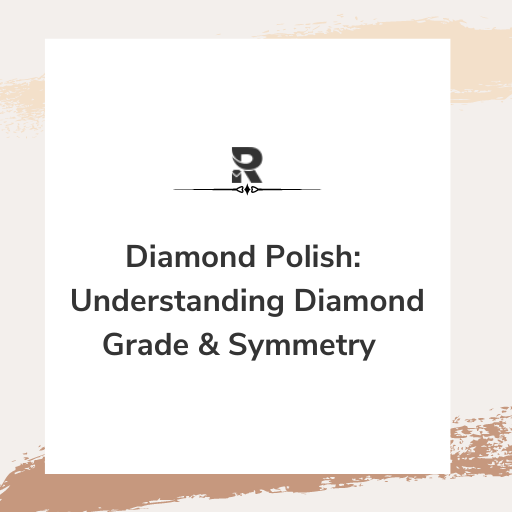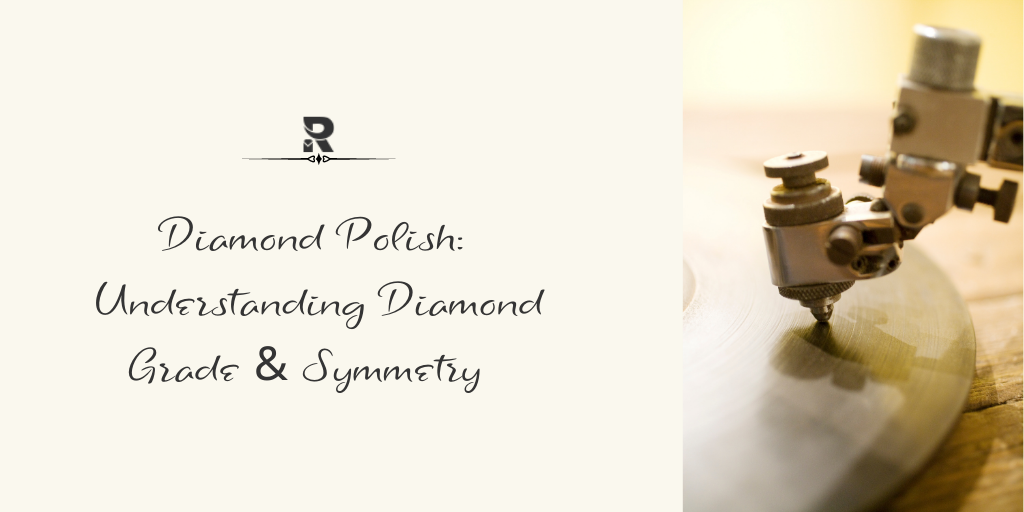
What is diamond polish? What kind of diamond should you be looking for when you go to buy one? What factors should you know before buying a diamond by yourself?

With this article, you will get to know about various such things- diamond grades & polishing. This shall help you choose the best gem for you.
Diamond quality check
The overall quality of a diamond is determined by diamond polish and diamond symmetry. Polishing is the key step in the manufacturing of a diamond which brings out the shine and sparkling effect in the diamond. It is what takes place after a diamond is cut out of a rough diamond stone.
Diamond Polish
Diamond polish is related to the quality of the facet surfaces. Facets are like tiny mirrors that reflect light. These are clear-cut and smooth surfaces that determine the quality of the diamonds. Any defects in them can cause altered bouncing of light that is the main reason for the dullness of diamonds.
The facets can get damaged along with the passage of time. Micro bulges, cracks can be formed that reduce the quality and shine of the diamond. For the removal of such damages, diamond polishing is done to improve the quality of the diamonds.
Using fine diamond dust for polishing the diamond for a long period of time gives higher grade polishing. There are polishing grades that determine whether a diamond is of higher or lower quality. Which we will be elaborating on later in the article.
What are the flaws and blemishes on the diamond?
There are some minuscule polish marks on facets of a diamond. These may vary in their nature and number. Some features that GIA considers for a polish grade are-
Nick: It is a notch on the surface of the facet that does not seem to have depth. It is like a minute notch on the diamond’s surface.
Scratch: It is a line-like mark on the surface of the diamond. It is an almost transparent line on the facet that does not appear to have depth. It is not an easy thing to scratch a diamond. It can be repolished and its shine can be regained.
Pit: It is a tiny dot that resembles a pinpoint, it can occur during the manufacturing of the diamond.
Abrasion: These are small cuts and nicks that are formed at the intersection of facets.
Polish line: These are translucent or white fine lines that are hardly visible. These can affect the shine if they are extreme.
Burn mark: A white mark on the surface of the diamond due to excess heat applied during the process of polishing. It is the result of high temperatures.
Lizard skin: Bumpy texture on the surface of the diamond that looks like natural diamond skin.
Rough girdle: It is a rough skin patch on the girdle. It is not easy to polish it.
Extra facet: During the manufacturing, an extra facet is formed, which then leads to false bending of light through the diamond.
Natural: It is a rough patch of skin that occurs on the surface near the girdle and remains on the diamond.
Also read: Diamond Carat: Understand Sizing and Measurement Guide
Diamond Polish Grades
The smoothness of each facet determines the grade of the diamond. This process takes place under the observation of a gemologist with the help of magnification, as it is very important to focus on all the tiny blemishes and defects on the facet surfaces. There are several GIA polish grades. Excellent, Very Good, or Good are high-quality grades.
Let’s look at different polish grades-
Excellent: No blemishes or flaws are visible at 10x magnification. There is an ideal reflection of light that gives a perfect shine to the diamond. It is the highest quality polish grade.
Very Good: There are minor polish flaws that are difficult to spot unless under 10x magnification. It also gives you a similar shine with a minute difference as compared to Excellent grade polishing. You can go for Very Good polish as it cuts down the price a little and you save some money and still get great results.
Good: One can not find much difference between Good and Excellent polish grades without knowledge of it. Polish defects are still difficult to find in Good polish grade up to 10X magnification. So you can choose this polish for a lower price and good outcome.
Fair: Some polish defects are seen under 10x magnification. Also, these are visible with naked eyes. There are finishing errors in this polishing. It is a low-quality polish grade that should be avoided.
Poor: Least quality polishing in which there are visible flaws and blemishes that can be noticed with naked eyes easily. It is not recommended as it reduces the shine of the diamond.
High-quality polish grades, Excellent to Good, are preferred in most of the cases, as these result in the best quality diamonds. Even Fair grade polishing works on the diamonds below 0.75 carats. For such diamonds, Fair or any above polis will not affect the looks of the diamond for a common person.
These fine differences can only be determined by some trained person or a professional gemologist. But in any condition, the Poor grade of polish should be strictly avoided.
Diamond Symmetry
Diamond Symmetry is referred to as the precise alignment and intersection of facet surfaces. It is another important measure that determines a diamond’s quality. Poor diamond symmetry can result in false dispersion of light inside the diamond. Also, extra facets can misdirect the light that travels inside the diamond which reduces its shine and sparkling effect.
Diamond Symmetry Grades–
There are symmetry grades given to the diamonds from ‘Excellent’ to ‘Good’ in order to compare different diamonds. Poor quality diamond symmetry should be strictly avoided as the symmetry defects in such cases are clearly visible to naked eyes.
Brief about various diamond symmetry grades-
Excellent: No symmetry defects are visible up to 10x magnification. It is the highest symmetry grade of the diamond.
Very Good: It is extremely difficult to observe symmetry defects under 10x magnification. It is preferable as it is almost similar to the Excellent diamond symmetry grade.
Good: The defects are difficult to be seen under 10x magnification and even with naked eyes. It is a good option for you to choose a diamond of good quality.
Fair: The defects are visible under 10x magnification and even with naked eyes. It is a low symmetry grade diamond.
Poor: The defects are clearly visible with naked eyes in this case. These are not recommended at all.
Diamond polish or symmetry, what is the priority?
Diamond symmetry is an important factor and it should be taken into consideration when it comes to diamond symmetry and polish.
While a polish defect is not visible easily but the symmetrical difference can be noticed more in comparison. Here diamond polish becomes a secondary factor to symmetry. A diamond should not be chosen or rejected on the basis of just symmetry.
The symmetry can not alone decide the quality of the diamond as the minute surface defects are major things to be noticed. Instead allover cut grade should be used as the primary measure since it incorporates symmetry inside it.
How do polish and symmetry affect the price of the diamond?
A big question that customers might be curious about. Some people think of saving a good amount of money by choosing lower grades of polishing and symmetry of a diamond. Well, that is not the answer.
There is a demand for Excellent diamond polish and symmetry so there are few diamonds with Excellent cut grades. Due to this a diamond with a Very Good grade and polish can also work and here is where you can save a few bucks. A diamond with Excellent symmetry may be priced up from 15% to 10% as compared to a Good grade symmetry.
All in all the quality affects the price of the diamond if not much then less. It is suggested not to compromise quality for a few bucks, it will only be beneficial to you in the long run. Do not opt for the Poor grades of diamond polish or diamond symmetry. You can prioritize your factors and choose the best diamond for yourself.
A tip to maintain your diamond ring
Wondering how to self-polish your precious diamond? Or better say maintain your diamond. It is better to keep your diamond safe and clean in the long run. You can keep it clean and maintain its brilliance and shine for a longer period of time.
Although you can not practically polish your diamond ring like a gemologist, you can still wash it with soap and water thoroughly. To polish your ring’s setting, do ensure it is not loose and there are no prongs and bulges.
Also read: How to determine the value of a Black diamond?
Conclusion Thoughts
All these facts and descriptions on diamond polish and diamond symmetry will turn out to be helpful to you when you go shopping. It will help you not just in buying a perfect diamond for yourself but also verify the best grades of diamond polish and symmetry. Once you are known and aware of the facts related to diamonds it becomes easier for you to make a perfect selection and find the best diamond that shines bright like you.